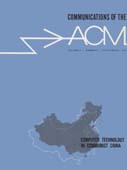September 1966 - Vol. 9 No. 9

Features
Computer technology in communist China, 1956-1965
Based on information from translations of Communist Chinese news items and periodical literature for the 1956 through 1965 period, computer technology in China is reviewed under the following headings: (1) initial planning, organization and educational aspects of computer technology and automation; 2) machine development progress: two major specific machines in 1958-59, with Soviet aid; a vacuum in 1960-64 due to the withdrawal of Soviet aid; then presumably all-Chinese-made machines from 1965 to the present; (3) computer applications; (4) the trend of automation: control of production processes rather than data processing; and (5) the “Yun Ch'ou Hsueh” (Science of Operation and Programming) campaign of 1958-60, during which an attempt was made to bring concepts such as linear programming to ordinary Chinese workers and peasants. Communist China is adjudged to have a marginal computer capability, with most of its machines probably being of a binary nature; however, a turning point may have been reached in mid-1965.
Mathematics for undergraduate computer scientists
The mathematical requirements for an undergraduate program in Computer Science are a subject of debate. The Association for Computing Machinery's Curriculum Committee, however, believes that these requirements are essentially the same as the mathematical content of physical sciences undergraduate programs. The Committee believes that these requirements should assure the student of a broad mathematical background and should enable him to take a wide variety of courses in other scientific disciplines. The Committee's concern is to develop a solid scientific approach to Computer Science.
SIMULA: an ALGOL-based simulation language
This paper is an introduction to SIMULA, a programming language designed to provide a systems analyst with unified concepts which facilitate the concise description of discrete event systems. A system description also serves as a source language simulation program. SIMULA is an extension of ALGOL 60 in which the most important new concept is that of quasi-parallel processing.
A final solution to the Dangling else of ALGOL 60 and related languages
The dangling else problem consists of a class of potential ambiguities in ALGOL-like conditional statements whose basic form is “if B1 then if B2 then S1 else S2” where B1 and B2 are Boolean expressions and S1 and S2 are basic statements. The difficulty lies in whether to attach the else to the first if or to the second one. Existing solutions to the problem are either ambiguous or unnecessarily restrictive. Let S and S1 be statements. We define S to be closed if “S else S1” is not a statement, and to be open if “S else S1” is a statement. Thus an unconditional statement is a closed statement. Open and closed conditional statements are defined by syntax equations in such a way as to preserve openness and closure. In each case, an else must always be preceded by a closed statement. It is shown that the syntax equations are unambiguous, and that any change in the statement types required within the syntax equations would lead to either ambiguity or unnecessary restriction.
Half rotations in N-dimensional Euclidean space
An iterative procedure is described for determining half rotations in n-dimensional Euclidean space. The method is a variant of the cyclic Jacobi procedure and utilizes elementary plane rotations to obtain the half rotation matrix. Numerical examples are given.
Systematic generation of Hamiltonian circuits
For a combinatorial matrix which may specify both directed and nondirected arcs, the paper describes a computer program which generates systematically and exhaustively all the Hamiltonian circuits. Specific application is made to the “traveling salesman” problem.



